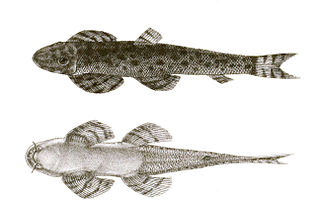Oreonectes is a genus of fish in the family Nemacheilidae found in the rivers and caves of Asia. Many of these species are troglobitic.

Rostroraja is a genus of skate belonging to the family Rajidae, native to the Atlantic Ocean and East Pacific, including the Mediterranean, Caribbean, Gulf of Mexico and Gulf of California. The genus was considered monotypic in the past, but a number of species usually classified in Raja have been reassigned to this genus based on genetic analysis.

Balitora is a genus of ray-finned fishes in the family Balitoridae endemic to Asia.

Cirrhimuraena is a genus of eels in the snake eel family Ophichthidae.
Erromyzon is a genus of fish in the family Gastromyzontidae endemic to China and Vietnam.
Formosania is a genus of gastromyzontid loaches, most of which are endemic to mainland China. Two species, F. lacustris and F. tengi, are endemic to Taiwan.

Micronemacheilus is a genus of freshwater ray-finned fishes belonging to the family Nemacheilidae, the stone loaches. The loaches in this genus are found in eastern Asia.
Bibarba is a genus of loach that is found in the Chengjiang River and Hongshuihe River in China.

Bangana is a genus of fish in the family Cyprinidae, the carps and minnows. It is distributed across much of southern and eastern Asia. Species live mainly in the flowing waters of tropical and subtropical rivers.

Carassioides is a genus of cyprinid fish that occurs in East and Southeast Asia.
Discocheilus is a genus of freshwater ray-finned fish belonging to the family Cyprinidae, the carps, barbs, minnows and related fishes. The species which belong to this genus are endemic to China.
Hongshuia is a genus of freshwater ray-finned fishes belonging to the family Cyprinidae, the family which includes the carps, barbs, minnows and related fishes. These fishes are endemic to China.
Luciocyprinus is a genus of freshwater ray-finned fish belonging to the family Cyprinidae, the family which includes the carps, barbs, minnows and related fishes. The fishes in this genus are found in China and Southeast Asia.
Mekongina is a genus of freshwater ray-finned fish belonging to the family Cyprinidae, the family which includes the carps, barbs, minnows and related fishes. The fishes in this genus are found in Southeast Asia and China.
Sikukia is a genus of freshwater ray-finned fishes belonging to the family Cyprinidae, the family which includes the carps, barbs and related fishes. This fishes in this genus are found in eastern Asia.
Eonemachilus is a genus of ray-finned fish belonging to the family Nemacheilidae, the stone loaches. The fishes in this genus are found in China.

Troglonectes is a genus of troglobitic fish in the family Nemacheilidae, native to caves of Asia. Fishbase and other authorities place these species in the genus Oreonectes.
Altigena is a genus of cyprinid freshwater fish found in the continental part of South East Asia. This genus was resurrected from Bangana by Maurice Kottelat in 2017.
Bashimyzon is a genus of freshwater ray-finned fishes belonging to the family Gastromyzontidae, a family which shares the common name hillstream loaches with the Balitoridae. These loaches are found in the Guangxi Province of China.
Karstinnectes is a genus of freshwater ray-finned fishes belonging to the family Nemacheilidae, the stone loaches. The fishes in this genus are cavefish found in China.






